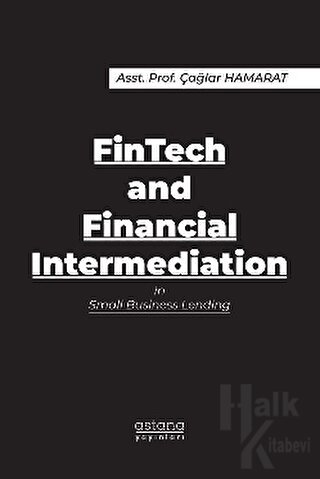FinTech and Financial Intermediation in Small Business Lending

This book focuses on the literature related to small business lending and financial technology (FinTech) in-cludes peer-to-peer (P2P) lending platforms and banks through the lens of financial intermediation theory.
Technology has always had an influence on the finan-cial sector, with new discoveries altering how it operates. FinTech is no different in this respect. For instance, the emergence and growth of online/mobile banking, and the usage of ATMs as a monetary transaction alternative to bank branches (Bons et al., 2012). So, what makes the pre-sent FinTech revolution so distinctive? I argue it is the role of technology in disintermediation and demonstrate this in the book.
From lending to asset management and portfolio advis-ing to the payment system, new digital technologies auto-mate a wide variety of financial processes and can deliver new and more cost-effective solutions in numerous sec-tions of the financial industry (Vives, 2017). FinTech's ef-fect is beginning to be seen in the banking industry and cap-ital markets in these categories. That said, the focus of this book is on the role of the alternative lenders that utilize peer-to-peer technology.
Specifically, new or enhanced financial goods and ser-vices, production processes, and organizational structures that can better serve the demand of financial system partic-ipants while reducing costs and risk procedures have all contributed to the expansion of financial inclusion. Thanks to these advantages, in the field of lending, which is one of the most basic functions of banking, alternative FinTech lenders, provide retail consumer and small business loan customers throughout the world a source of funding. The subsequent literature review is structured to react to a de-mand for research on this financial innovation and to add to the body of academic and financial literature.
In this book, I discuss the relevant literature on small business lending through traditional banking, FinTech and disintermediated finance.
- Açıklama
This book focuses on the literature related to small business lending and financial technology (FinTech) in-cludes peer-to-peer (P2P) lending platforms and banks through the lens of financial intermediation theory.
Technology has always had an influence on the finan-cial sector, with new discoveries altering how it operates. FinTech is no different in this respect. For instance, the emergence and growth of online/mobile banking, and the usage of ATMs as a monetary transaction alternative to bank branches (Bons et al., 2012). So, what makes the pre-sent FinTech revolution so distinctive? I argue it is the role of technology in disintermediation and demonstrate this in the book.
From lending to asset management and portfolio advis-ing to the payment system, new digital technologies auto-mate a wide variety of financial processes and can deliver new and more cost-effective solutions in numerous sec-tions of the financial industry (Vives, 2017). FinTech's ef-fect is beginning to be seen in the banking industry and cap-ital markets in these categories. That said, the focus of this book is on the role of the alternative lenders that utilize peer-to-peer technology.
Specifically, new or enhanced financial goods and ser-vices, production processes, and organizational structures that can better serve the demand of financial system partic-ipants while reducing costs and risk procedures have all contributed to the expansion of financial inclusion. Thanks to these advantages, in the field of lending, which is one of the most basic functions of banking, alternative FinTech lenders, provide retail consumer and small business loan customers throughout the world a source of funding. The subsequent literature review is structured to react to a de-mand for research on this financial innovation and to add to the body of academic and financial literature.
In this book, I discuss the relevant literature on small business lending through traditional banking, FinTech and disintermediated finance.
- Taksit Seçenekleri
- Axess KartlarTaksit SayısıTaksit tutarıGenel ToplamTek Çekim85,0085,00244,2088,40330,0390,10615,3091,80910,3993,50Finansbank KartlarıTaksit SayısıTaksit tutarıGenel ToplamTek Çekim85,0085,00244,2088,40330,0390,10615,3091,80910,3993,50Bonus KartlarTaksit SayısıTaksit tutarıGenel ToplamTek Çekim85,0085,00244,2088,40330,0390,10615,3091,80910,3993,50Paraf KartlarTaksit SayısıTaksit tutarıGenel ToplamTek Çekim85,0085,00244,2088,40330,0390,10615,3091,80910,3993,50Maximum KartlarTaksit SayısıTaksit tutarıGenel ToplamTek Çekim85,0085,00244,2088,40330,0390,10615,3091,80910,3993,50World KartlarTaksit SayısıTaksit tutarıGenel ToplamTek Çekim85,0085,00244,2088,40330,0390,10615,3091,80910,3993,50Diğer KartlarTaksit SayısıTaksit tutarıGenel ToplamTek Çekim85,0085,002--3--6--9--
- Yorumlar
- Yorum yazBu kitabı henüz kimse eleştirmemiş.
- Yayınevinin Diğer Kitapları


















